Some thoughts and disagreements on The Matrix as a trans allegory 📽🏳️🌈
This post was originally published on Medium in 2017.
Late in 1999 I was feeling pretty lost. I had a good life by most measures but something was wrong. I’d felt it since childhood but when puberty hit, it went from “feeling different” to “the bad feeling”. Whenever I tried to bring it up with someone I was made to feel disgusting or broken. I’m transgender but back then I didn’t even know what to call it. Were there others like me? Was there something wrong with me? Few things seemed to help but distractions such as videogames and films allowed me to briefly escape my feelings. In late September 1999 I rented a new sci-fi action film everyone was talking about. I pushed the tape into my trusty VHS player, huddled up in bed, and watched The Matrix for the first time.
In Neo I immediately saw a reflection of myself but I didn’t immediately read much into it. When you’re trans it’s easy to find characters to identify with because the transgender experience is a very human experience. A lot of trans people find characters to relate to in Disney, simply because many of their stories handle identity and being your true self. I saw Neo feeling lost, knowing that something was up but not even knowing what to call it. He would stay awake for hours at night on his computer, searching for answers, wondering if anyone out there felt like he did. I thought “here’s a character who feels lost like me” but I didn’t read more into it than that. Then the next scene spoke to me too. And the next. I started to have an unsettling feeling that this film knew more about me than I did, much like Neo watching someone else’s words flash across his computer. “Knock knock”. I’ve related to characters in films before but I got an eerie sense that The Matrix was created just for me. My heart was racing when Neo finally met Morpheus. Imagine baby trans Jen taking this in:
“You’re here because you know something. What you know you can’t explain, but you feel it. You’ve felt it your entire life, that there’s something wrong with the world. You don’t know what it is, but it’s there, like a splinter in your mind, driving you mad.”
What if I told you (in my best Morpheus voice) that The Matrix is a trans allegory touching on themes such as denial and acceptance of gender identity; trans erasure in death; the diversity of transition experiences (not everyone uses hormone therapy, others even regret transitioning etc); and that trans activism and education are necessary if we want to live in a peaceful world?
In the words of Neo…
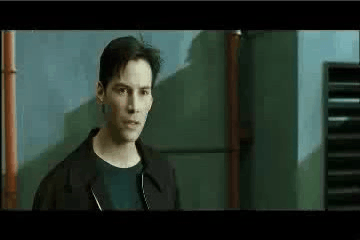
Art isn’t static
The Matrix was written and directed by two trans sisters, Lana and Lilly Wachowski, who have stated that trans themes appear in much of their work but nowhere as obviously as in The Matrix. When asked about fans looking back at the film, with new knowledge that both creators are trans women, Lana Wachowski once said that “art isn’t static”. I couldn’t agree more and this gets to the heart of why I want to write this piece.
Viewing art with a fresh pair of eyes can be like experiencing it for the first time all over again. Consider the many different perspectives people could have when viewing The Matrix. It’s obvious that a cisgender person (someone who isn’t trans - these are Latin prefixes), will likely interpret the film differently than a trans person would. Perhaps you may interpret the film differently before compared with after learning that the Wachowskis are trans women. That said, some people can’t see it at all:
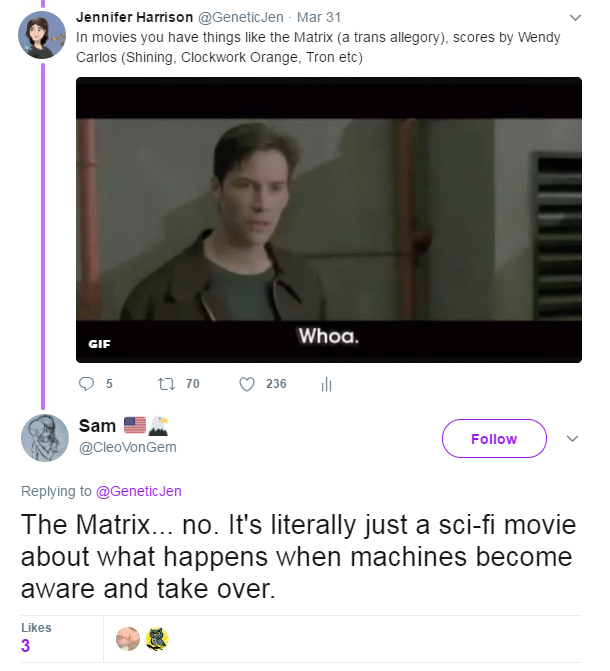
For me, always watching as a trans person, the interpretation of the film has evolved just as I have over the years. Art isn’t static. Of all the themes and metaphors you will read in this piece, I think I recognised about 25% of them during that very first viewing in my bedroom as baby trans Jen. I saw things that my friends didn’t, because they had no trans experience whatsoever. Over the years I’ve gleaned more and more from the film because of my own personal journey. As I grew up I learned trans terminology; I learned there were others like me; I learned about hormone replacement therapy; I learned about haters, chasers, and allies. As my own trans experience evolved, I noticed more of the trans allegory in scene after scene until the film became a living, breathing thing that changed alongside me.
Another reason for emptying these thoughts onto the internet is because I disagree, on many points, with others who have covered it before. I read some of the characters and scenes very differently. More importantly, I don’t think the trilogy has been given enough attention as a trans allegory. When viewed as generic sci-fi action films, the sequels really don’t do the original justice. As a trans allegory, however, they build on the original brilliantly and I think the people who miss the allegory also miss what makes the sequels interesting. Indeed, I believe many aspects of the sequels don’t make sense unless viewed as a trans allegory. I believe this is worth looking at closely and discussing further.
In order to share what I’ve taken from the film I need to provide a little perspective, so this piece necessarily has to touch on personal stories too. My goal is to give you some insight so that you (especially if you’re cisgender) can empathise and see why the film speaks to me and many other trans people. This might not be your average film analysis (actually it’s best to just consider this venting) but stick with me and and I’ll show you how deep the rabbit-hole goes.
Plugged into the cis-tem
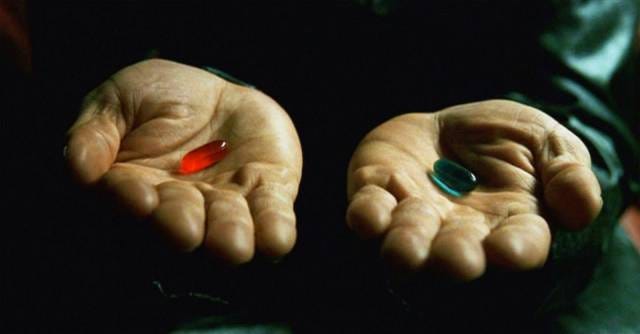
Neo is obviously at the core of The Matrix. In the trans allegory, his journey to become “the One” is also his journey to become his true self. Whether you’re following the sci-fi plot or the trans allegory, Neo starts by knowing there’s something up, though he doesn’t know exactly what. There’s definitely more to his world. Then he comes to learn what he is by meeting other people who also felt the way he does. That doesn’t necessarily mean he accepts it or fully believes it himself. He has forces in his life that believe in him and others that threaten him, but through struggles Neo comes to accept himself and who he really is. This arc, taking Neo from discovering the truth to accepting his identity, takes place over the entire first film. The sequels handle the necessity of activism, the diversity of transitioning experiences, and peace.
“The Matrix is a system, Neo. That system is our enemy. But when you’re inside, you look around, what do you see? Businessmen, teachers, lawyers, carpenters. The very minds of the people we are trying to save.”
In the film, the matrix itself is one of two worlds or more accurately a world within a world. In the trans allegory, the matrix is simply how society sees gender. The matrix is cis-normative society. As Morpheus explains, that world or way of thinking is all around us. We see it on TV and we see it when we look out the window.
It’s no accident that the matrix was created by machines. It’s artificial. It’s a construct. All the humans living in the matrix are real biological beings trapped into thinking of gender in its most simplistic terms - not recognising trans people, and not recognising gender beyond the binary. Trans people break free from this system, which is represented in the film by our heroes being unplugged from the matrix itself.
“You have to understand, most of these people are not ready to be unplugged. And many of them are so inured, so hopelessly dependent on the system, that they will fight to protect it.”
Importantly, the cis people obliviously walking around in the Matrix are not the enemy; the system is the enemy. There are people out there who say that Black Lives Matters is anti-white, or feminism is anti-men, and that’s obviously bullshit. Similarly, being a trans allegory doesn’t make The Matrix anti-cis. In fact, the allegory paints cis people as victims in this system too and argues that — ultimately — peace comes from understanding and cooperation between trans and cis people.
“It is the world that has been pulled over your eyes to blind you from the truth.”
“What truth?”
“That you are a slave, Neo. Like everyone else you were born into bondage. Into a prison that you cannot taste or see or touch. A prison for your mind.”
The earliest scenes in the film are the most obvious, even to cis people. When Neo begins his journey he is given a choice between the red pill or the blue pill. Many trans people take pills as part of their hormone replacement therapy during transitioning. The fact that assholes online have accidentally co-opted the red pill from a trans allegory created by two trans women is both disappointing and unintentionally hilarious. Side-note: It’s important to note that some trans people don’t undergo hormone replacement therapy (HRT) and they are just as valid as trans people. The Wachowskis address this brilliantly in the sequels and anime projects through Kid, a character who wakes himself up from the matrix without the aid of any pills at all. In the allegory, he’s a trans person who accepts himself and transitions without HRT. He looks up to his trans heroes and he’s one of them without taking any pills. But I digress, we’ll get to the sequels another time.
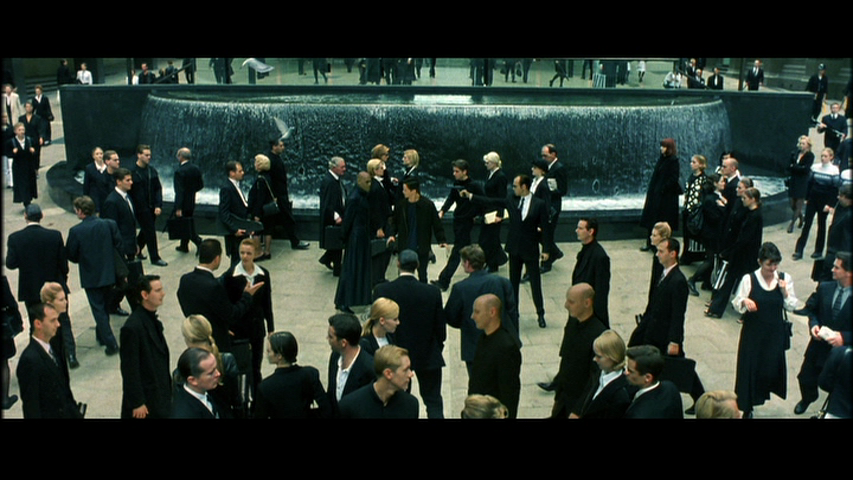
The Morpheus quotes I’ve been using come from a training scene where Neo learns about agents. It’s extremely powerful but I don’t believe it hits as hard for cis people. The agents are the real enemy. They’re a consequence of the system. They represent fear and hatred of the people unplugged. They’re the oppression of trans people. You can think of them as actual individuals in the sense of transphobic bigots but in the allegory they also represent that fear and hatred as a concept.
I’ve watched many films that openly feature trans people and no other has so accurately captured the feeling of walking down a busy street as a trans person. When I walk into town I know that most of the people around me are good, decent people. Most would probably come and help me if I was attacked or hurt. However, it’s also a fact that an alarming number are hostile to trans people. At best they might ridicule me; at worst they might try to murder me. The terrifying thing is that transphobes don’t have signs hovering above their heads. Until they actually attack, they look just like everyone else. They blend in. When you walk through a sea of people, you have no idea who could really be filled with that hatred, so you have to be ultra vigilant around everyone.
You don’t know who could be an agent.
Trans stories
Neo is the core of the trans allegory but the cast he meets are equally important. Some of them represent aspects of his own journey (especially Morpheus and Agent Smith, who we’ll come to) but other characters tell specific trans stories. There’s Switch, the only character who was specifically written as transgender. She’s the embodiment of the allegory; of being unplugged. Originally the role was to be performed by two actors, one male and one female, to give her a different body when inside or outside the matrix. The sci-fi aspect here is that there’s a glitch in the matrix that left her with a mental projection that doesn’t match her gender. (I’m going to continue using she/her pronouns for Switch because it’s canon now and you know who I’m talking about).
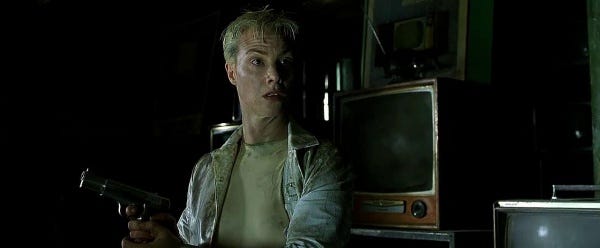
The production companies didn’t like this and had the Wachowskis play down the trans aspect and have the character performed by one actor. The Wachowskis compromised in several ways. Firstly, they hired an androgynous actor, which is probably the next best thing. Most importantly, they kept her character the same. We still know her as Switch, a name that references the switching between bodies as she plugs in and out of the matrix. She even keeps the white clothing while everyone else wears black; a visual queue to help viewers realise the two appearances in the original vision are the same character. Even better, she keeps her original dialogue. Her death scene isn’t exactly nonsensical, but it makes much more sense when you realise that the Wachowski’s engineered a scene in order to talk about trans erasure in death.
Many people come out to find that their relatives and loved ones are unsupportive or even hostile to trans people. It’s also a fact that a scary number of trans people die each year, sometimes from suicide or murder. Sadly, many of these unsupportive families erase the dead’s identity by deadnaming them and ignoring their transness. Obituaries and gravestones show deadnames. This is really common. In the allegory, the Wachowskis give these dead people a voice by engineering a situation where Switch knows she’s about to die. So there she is: back in the world she tried so hard to escape from, and in the body she tried so hard to escape from. Her last words might as well be those of all the trans people who have had their identity erased in death. “Not like this. Not like this.”
The biggest disagreement I have with others is over Cypher, who most people interpret as a chaser. I can see where this thought comes from as he hangs around the heroes, uses them, turns on them, and there’s clearly attraction involved with Trinity. I feel this oversimplifies one of the best characters in the film and a big part of the allegory. I think this view falls down when you consider that Cypher is unplugged, like the others, so he’s a trans person who has transitioned. The difference is that he’s unhappy. He’s jealous of others around him like Neo. And most importantly, he’s filled with regret. He doesn’t like this new world he finds himself in and wants to go back. Just as the sequels bring up more nuanced issues like transitioning without hormone therapy, the original film brings up the fact that there are people out there who wish to detransition.
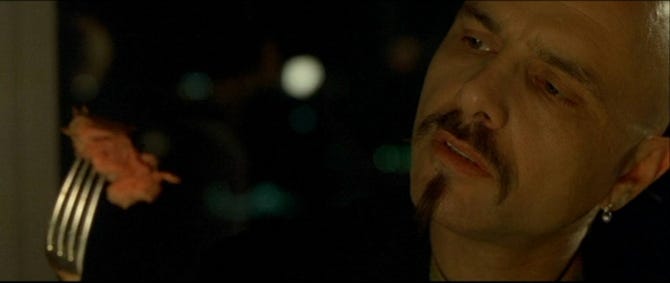
The most striking parallel with Cypher’s story and our world is that many people who detransition are used by transphobes in order to attack trans people further. People who detransition are seen as proof that there’s something wrong with being transgender or that society is forcing people to transition when they clearly don’t need to. Lo and behold, the agents use Cypher’s detransition back into the matrix to get to the heroes. They capitalise on his struggle. They appear as his allies but ultimately use him to deal a blow to the community he wishes to leave. We’re watching real-life play out on the Nebuchadnezzar.
The worst part of yourself
Not all agents are born equal and Agent Smith plays a special role in The Matrix as both a film and a trans allegory. He’s unique, even as an agent. He still represents fear and hatred of trans people as the other agents do, but for him it’s also self-hatred. As the Oracle eventually explains, Agent Smith and Neo are one and the same. They are flip sides of each other. Two halves of an equation. Equal yet opposite. Agent Smith is a failed “One” while Neo goes on to become successful. In the allegory, Neo eventually comes to accept his trans identity but Agent Smith does not. In some ways you can view Agent Smith as his own person, like a self-hating trans individual, but in almost every scene he also acts as a fearful, hateful aspect of Neo himself.
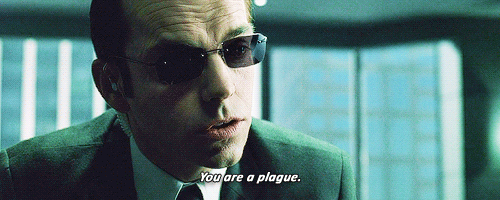
Being another agent, Smith always represents hostility towards trans people, but he clearly plays by his own rules and has his own purpose. Every action he takes represents Neo’s fear and doubt. Whenever he speaks to Neo, he deadnames him. Always Mr Anderson; never Neo. He captures and tortures Morpheus, who represents the hope and belief Neo has in himself (I’ll get to that). Agent Smith is the part of you that tries to keep you down, sow seeds of doubt, and tell you what isn’t possible. Your failure is inevitable.
Let’s step back from the film for a moment and talk about something that really happened. Content warning: contemplation of suicide. Years before filming The Matrix, Lana Wachowski hit an all-time low in terms of gender dysphoria and willingness to accept herself as trans. She decided to take her own life by walking down into a subway and jumping in front of an approaching train. She fought with herself and at the last moment changed her mind. Down there in the subway, she accepted her identity and from that moment knew she could live a genuine life as her true self. Facing your darkest self in a subway sounds familiar, no?
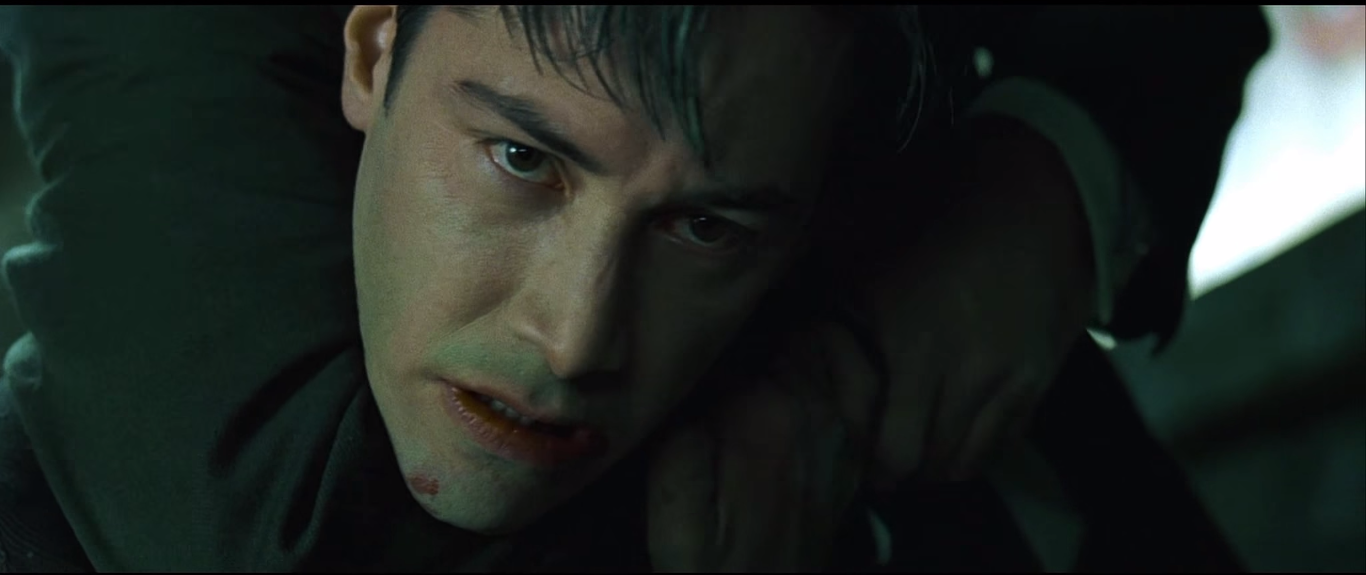
For my teenage friends, back in 1999, the subway scene was just another great moment of action; but for trans viewers it’s the emotional crux of the film. Neo is being hunted relentlessly by agents and comes face to face with Agent Smith, where he is pinned and appears doomed to be hit by the incoming train. Agent Smith, deadnaming Neo as usual, describes his death as inevitable. The train is coming and one way or another, “Mr Anderson” is going to die.
“My name… is Neo.”
Up until this moment Neo has been struggling to believe in himself and accept who he is. He clearly wants to believe but with so many forces against him it’s difficult. In this scene, like Lana Wachowski when she was in the real-life subway, Neo finds the bravery to fight for his life and begin accepting himself. As Morpheus says, “he’s beginning to believe”.

While Smith can be seen as the part of Neo that is self-hating and scared, Morpheus is the part that believes in himself. It’s no accident that many of the challenges Morpheus faces are from people who simply ridicule that belief. Just as in real life, transphobia comes in different forms. It’s true that trans people face violent hatred in the real world but we also face more subtle, casual transphobia and doubt from people close to us. Many attacks from transphobes are forms of emotional abuse. Some of the characters in this fictional universe aren’t violently aggressive towards Neo but they clearly have strong opinions about whether or not Morpheus is insane for believing in the One. I’m also often told I’m insane for being trans. If Agent Smith is the part of Neo trying to get him to give up, Morpheus is the part that knows the truth deep down. For me Morpheus represents belief either in yourself or belief and support from others. He picks you up when Smith knocks you down. This is an area where I disagree with others who have written about the trans allegory. Most writers see Morpheus as an older, wiser trans person who gives guidance. (If anyone plays that role I believe it’s the Oracle, who has some answers but insists you have your own story to understand). Agent Smith tells you that what you’re doing is impossible. Your failure is inevitable. When Smith is the voice saying you can’t do it, Morpheus is the voice saying you can.
Why do you persist?
When I started typing this piece I envisaged a well-structured article covering the entire trilogy. Instead it turned into this rambling outpouring of opinions mostly about the first film. I’m OK with that. I see personal pieces like this as entries in a diary of sorts. This is what I think about The Matrix. If anyone else gets something out of it then that’s cool. As a way for me to get my thoughts about the film out of my head, I’ve achieved my goal. I feel I’ve vented. I wanted to bring up a few aspects where I disagree with others and I did that. Mission accomplished. I feel better now.
That said, maybe you want more from this? Maybe I should really dive into the film properly? Maybe I should put my money where my mouth is and cover the continued trans allegory present in the sequels? Maybe. I’ll think about it. If there’s some demand, I could create a series of articles looking at each film individually. I am genuinely surprised that more people haven’t considered the sequels as continuations of the allegory. I’ve tried to watch them and focus on the sci-fi story alone, ignoring any hints of trans stories, and they’re really quite pointless. Perhaps I can help you enjoy them more by providing some of this context in a future entry, because both sequels are infinitely more rewarding when viewed through the lens of the trans experience.
Neo’s journey to become his true self is fantastic but so is his wider journey as an activist fighting for other trans people. I actually like the sequels and the direction they take the allegory. The first film finishes in the most perfect way for a continuation about becoming an activist and fighting for other trans people. When Neo talks directly to the machines at the end of the film, he’s talking directly to the hateful transphobes and people obsessed with enforcing the gender binary.
“I know that you’re afraid… you’re afraid of us. You’re afraid of change. I don’t know the future. I didn’t come here to tell you how this is going to end. I came here to tell you how it’s going to begin. I’m going to hang up this phone, and then I’m going to show these people what you don’t want them to see. I’m going to show them a world without you. A world without rules and controls, without borders or boundaries. A world where anything is possible. Where we go from there is a choice I leave to you.”
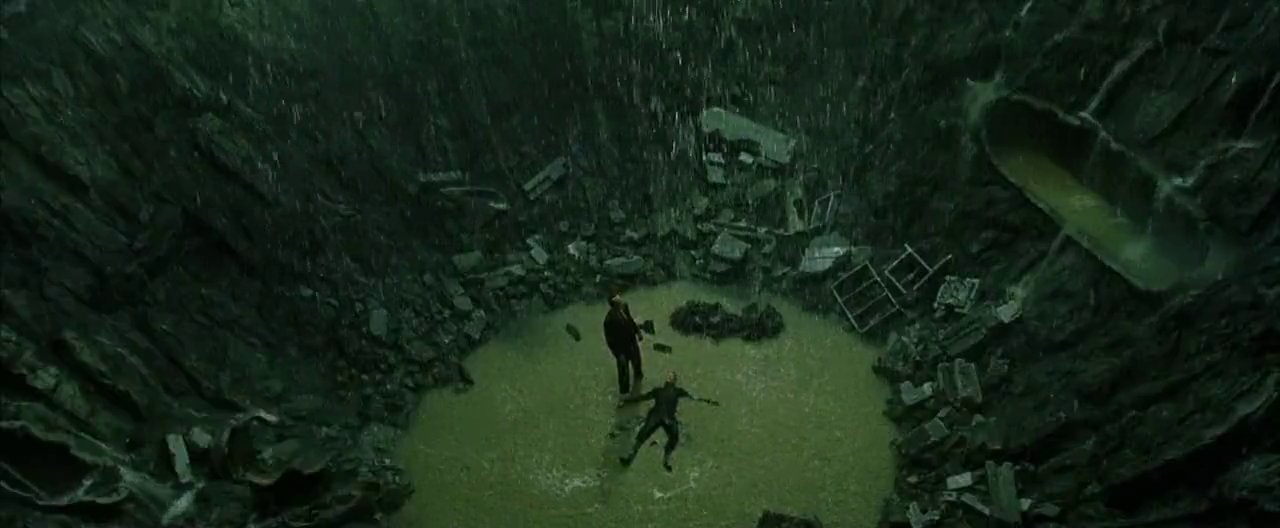
I’m not the biggest fan of action films but The Matrix means a lot to me. My friends tell me I’m brave just for being myself. I get death threats because of my gender. I’ve been assaulted for it. I’m violently hated by transphobes including some who stand against racism, homophobia, sexism etc. Every walk down the street requires extreme vigilance. Society seems determined to stop me, just like the forces standing against Neo. This is what makes him a brave hero for many trans people. He could take the easy way out at any opportunity but instead gets right back up every time he’s knocked down. In the climax of the third film, Agent Smith is sure he’s beaten Neo for good only to see him stand up once more. Agent Smith is the worst part of Neo. Deadnaming him again, Agent Smith asks the question that the worst part of me has asked myself far too often in the past:
“You must be able to see it, Mr. Anderson. You must know it by now. You can’t win. It’s pointless to keep fighting. Why, Mr. Anderson? Why? Why do you persist?”
“Because I choose to.”